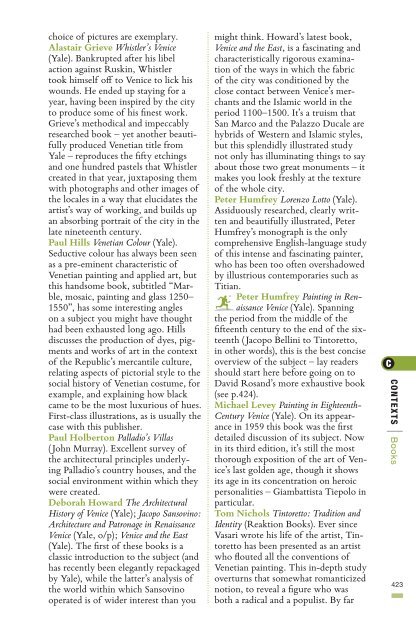Create successful ePaper yourself
Turn your PDF publications into a flip-book with our unique Google optimized e-Paper software.
choice of pictures are exemplary.<br />
Alastair Grieve Whistler’s <strong>Venice</strong><br />
(Yale). Bankrupted after his libel<br />
action against Ruskin, Whistler<br />
<strong>to</strong>ok himself off <strong>to</strong> <strong>Venice</strong> <strong>to</strong> lick his<br />
wounds. He ended up staying for a<br />
year, having been inspired by <strong>the</strong> city<br />
<strong>to</strong> produce some of his finest work.<br />
Grieve’s methodical <strong>and</strong> impeccably<br />
researched book – yet ano<strong>the</strong>r beautifully<br />
produced Venetian title from<br />
Yale – reproduces <strong>the</strong> fifty etchings<br />
<strong>and</strong> one hundred pastels that Whistler<br />
created in that year, juxtaposing <strong>the</strong>m<br />
with pho<strong>to</strong>graphs <strong>and</strong> o<strong>the</strong>r images of<br />
<strong>the</strong> locales in a way that elucidates <strong>the</strong><br />
artist’s way of working, <strong>and</strong> builds up<br />
an absorbing portrait of <strong>the</strong> city in <strong>the</strong><br />
late nineteenth century.<br />
Paul Hills Venetian Colour (Yale).<br />
Seductive colour has always been seen<br />
as a pre-eminent characteristic of<br />
Venetian painting <strong>and</strong> applied art, but<br />
this h<strong>and</strong>some book, subtitled “Marble,<br />
mosaic, painting <strong>and</strong> glass 1250–<br />
1550”, has some interesting angles<br />
on a subject you might have thought<br />
had been exhausted long ago. Hills<br />
discusses <strong>the</strong> production of dyes, pigments<br />
<strong>and</strong> works of art in <strong>the</strong> context<br />
of <strong>the</strong> Republic’s mercantile culture,<br />
relating aspects of pic<strong>to</strong>rial style <strong>to</strong> <strong>the</strong><br />
social his<strong>to</strong>ry of Venetian costume, for<br />
example, <strong>and</strong> explaining how black<br />
came <strong>to</strong> be <strong>the</strong> most luxurious of hues.<br />
First-class illustrations, as is usually <strong>the</strong><br />
case with this publisher.<br />
Paul Holber<strong>to</strong>n Palladio’s Villas<br />
( John Murray). Excellent survey of<br />
<strong>the</strong> architectural principles underlying<br />
Palladio’s country houses, <strong>and</strong> <strong>the</strong><br />
social environment within which <strong>the</strong>y<br />
were created.<br />
Deborah Howard <strong>The</strong> Architectural<br />
His<strong>to</strong>ry of <strong>Venice</strong> (Yale); Jacopo Sansovino:<br />
Architecture <strong>and</strong> Patronage in Renaissance<br />
<strong>Venice</strong> (Yale, o/p); <strong>Venice</strong> <strong>and</strong> <strong>the</strong> East<br />
(Yale). <strong>The</strong> first of <strong>the</strong>se books is a<br />
classic introduction <strong>to</strong> <strong>the</strong> subject (<strong>and</strong><br />
has recently been elegantly repackaged<br />
by Yale), while <strong>the</strong> latter’s analysis of<br />
<strong>the</strong> world within which Sansovino<br />
operated is of wider interest than you<br />
might think. Howard’s latest book,<br />
<strong>Venice</strong> <strong>and</strong> <strong>the</strong> East, is a fascinating <strong>and</strong><br />
characteristically rigorous examination<br />
of <strong>the</strong> ways in which <strong>the</strong> fabric<br />
of <strong>the</strong> city was conditioned by <strong>the</strong><br />
close contact between <strong>Venice</strong>’s merchants<br />
<strong>and</strong> <strong>the</strong> Islamic world in <strong>the</strong><br />
period 1100–1500. It’s a truism that<br />
San Marco <strong>and</strong> <strong>the</strong> Palazzo Ducale are<br />
hybrids of Western <strong>and</strong> Islamic styles,<br />
but this splendidly illustrated study<br />
not only has illuminating things <strong>to</strong> say<br />
about those two great monuments – it<br />
makes you look freshly at <strong>the</strong> texture<br />
of <strong>the</strong> whole city.<br />
Peter Humfrey Lorenzo Lot<strong>to</strong> (Yale).<br />
Assiduously researched, clearly written<br />
<strong>and</strong> beautifully illustrated, Peter<br />
Humfrey’s monograph is <strong>the</strong> only<br />
comprehensive English-language study<br />
of this intense <strong>and</strong> fascinating painter,<br />
who has been <strong>to</strong>o often overshadowed<br />
by illustrious contemporaries such as<br />
Titian.<br />
Peter Humfrey Painting in Renaissance<br />
<strong>Venice</strong> (Yale). Spanning<br />
<strong>the</strong> period from <strong>the</strong> middle of <strong>the</strong><br />
fifteenth century <strong>to</strong> <strong>the</strong> end of <strong>the</strong> sixteenth<br />
( Jacopo Bellini <strong>to</strong> Tin<strong>to</strong>ret<strong>to</strong>,<br />
in o<strong>the</strong>r words), this is <strong>the</strong> best concise<br />
overview of <strong>the</strong> subject – lay readers<br />
should start here before going on <strong>to</strong><br />
David Ros<strong>and</strong>’s more exhaustive book<br />
(see p.424).<br />
Michael Levey Painting in Eighteenth-<br />
Century <strong>Venice</strong> (Yale). On its appearance<br />
in 1959 this book was <strong>the</strong> first<br />
detailed discussion of its subject. Now<br />
in its third edition, it’s still <strong>the</strong> most<br />
thorough exposition of <strong>the</strong> art of <strong>Venice</strong>’s<br />
last golden age, though it shows<br />
its age in its concentration on heroic<br />
personalities – Giambattista Tiepolo in<br />
particular.<br />
Tom Nichols Tin<strong>to</strong>ret<strong>to</strong>: Tradition <strong>and</strong><br />
Identity (Reaktion Books). Ever since<br />
Vasari wrote his life of <strong>the</strong> artist, Tin<strong>to</strong>ret<strong>to</strong><br />
has been presented as an artist<br />
who flouted all <strong>the</strong> conventions of<br />
Venetian painting. This in-depth study<br />
overturns that somewhat romanticized<br />
notion, <strong>to</strong> reveal a figure who was<br />
both a radical <strong>and</strong> a populist. By far<br />
CONTEXTS<br />
| Books<br />
423







